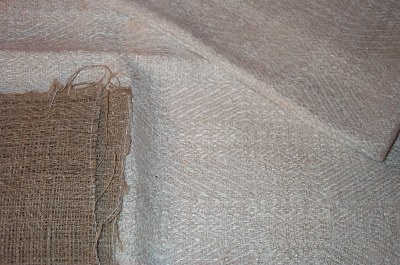| WOOLGATHERERS COLD MANGLING | ||||||
|
| COLD MANGLING |
EXPERIENCE A NEW “WRINKLE” IN FABRIC FINISHING
|
Detail photo showing fabric directly from loom next to finished towels.
Quite a difference. The electric mangle was a big help in getting the cloth and pattern to look nice.
|
After primary wet finishing, commercial fabrics are often “calendared” – in plain English, pressed between two rollers with varying amounts of pressure to smooth the finish on the fabric. In Northern Europe it has been traditional for centuries to press linens and other flat fabrics with a cold mangle – a device where the fabric is rolled on a wooden dowel and either rolled under pressure from a flat board held over it, or placed under a wooden bed containing heavy stones. Today, in Sweden, the mangles have been electrified – using two smooth aluminum cylinders under 380kg (800 pounds) of pressure. The fabric is fed onto the rollers using a flat linen cloth for the first 1.5 yards and then rolling the rest over top. I am pleased to announce a MANGLING SERVICE for weavers to put that beautiful flat finish on their handwoven items. Using the Swedish mangle pictured below, I can take your single items or finished yardage and press it flatter, with more sheen and pattern definition than is possible with any steam iron. The intersections where the threads cross are pressed indelibly, the surface (especially where linen thread is used) reflects light, and subtle patterns become more visible. |
|
Conditions: |
|
Minimum charge $10. |
Suitable Fabrics: |
Pure linen (especially white on white patterns and damask) Cotton/Linen blends Silks Woolen yardage with a smooth surface Felted/heavily fulled wool yardage Not suited for any fabrics with lofty surface interest, loops, lumps and bumps, collapse effects, differential shrinkage – the pressure may damage the desired textural effect. |
How do I arrange to have my yardage/fabric mangled? Please contact me first in case there are any special wishes or issues with your project. Use either the contact form on this web site, or give me a call at 920-929-9503 after 5pm or weekends. Then measure the length of your piece and place your cloth carefully on a roll. Send it along with following:
TO: Sara von Tresckow 35 N. Main St. Fond du Lac, WI 54935 The process is not a lengthy one – unless we are out of town or terribly busy, your return shipment should be on its way within 2 business days of receiving the fabric.
|
What will happen to my fabric? I’ll first unpack it, dampen it into a loose roll, pack in in a clean bedsheet, and let the moisture even out. Then the cloth will be fed onto the rollers in multiple passes – from each end, and using both surfaces facing up to assure even handling of all areas. When I’m satisfied that the mangling is completed, the fabric will be gently placed on a rack to dry. Then, it is lightly steam pressed as it is rolled back onto your supplied roll/tube. Packed with acid free tissue to keep the roll from collapsing, it will be repacked and shipped back to you.
|
Will this mangling wash out? The finish on your fabric will remain somewhat through gentle washings. I highly recommend the new front loader technology and NO dryer to maintain the smoothness. Once the yardage has been mangled in the electric device, use of a simple hand mangle will restore the beauty. A hand mangle can be made in the home using a wooden dowel (rolling pin will do) and a flat board rolled back and forth over the dowel package (your fabric plus a covering cloth). A light touch with your steam iron will finish the job. |
What will happen when I cut and sew my fabric? The nice finish on your fabric will not disappear if you cut and hem it. Any wrinkling will easily flatten out if you touch it up with your steam iron. |
What about the lovely damask table linen from my Grandmother? This process can restore the beauty of older table linens – especially damasks – provided that they are still in undamaged condition. Fragile textiles should be left as they are. I have done older pieces that I own, and a piece or two for others with lovely results. In one case the question of “Why would somebody go to all the trouble to weave this white on white pattern?” was answered quite successfully by mangling the piece. |
| TOP |


